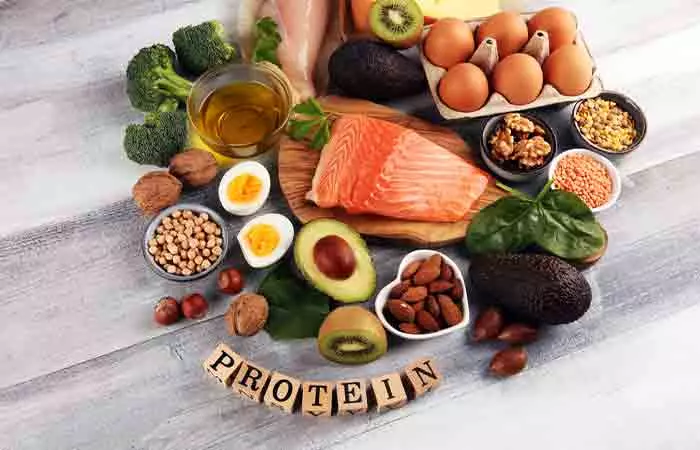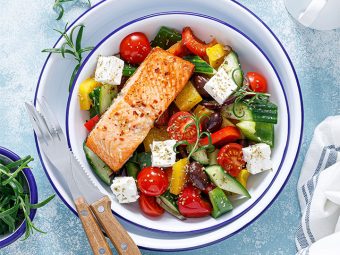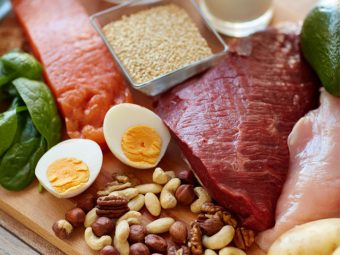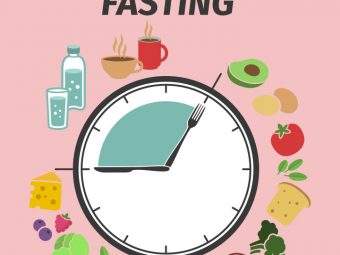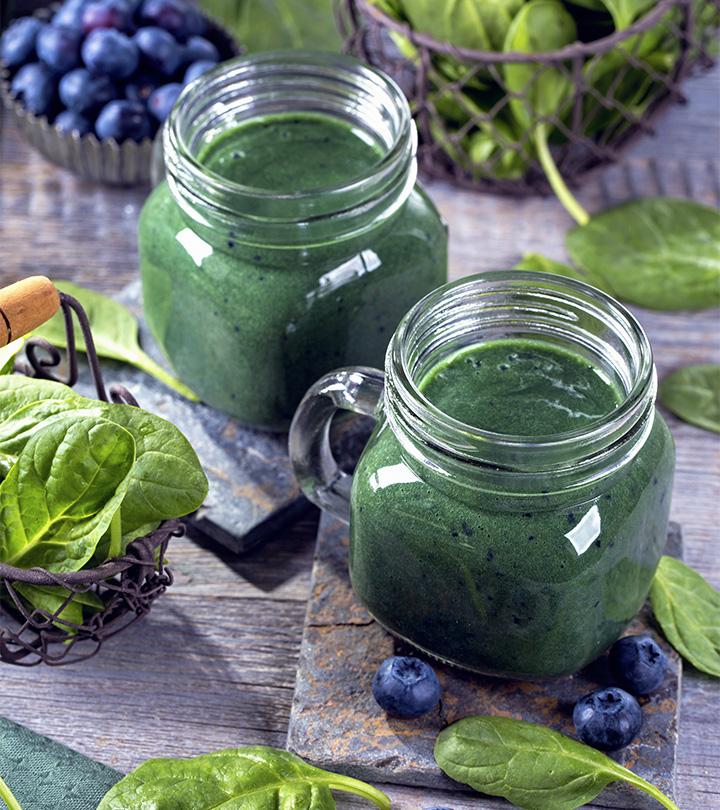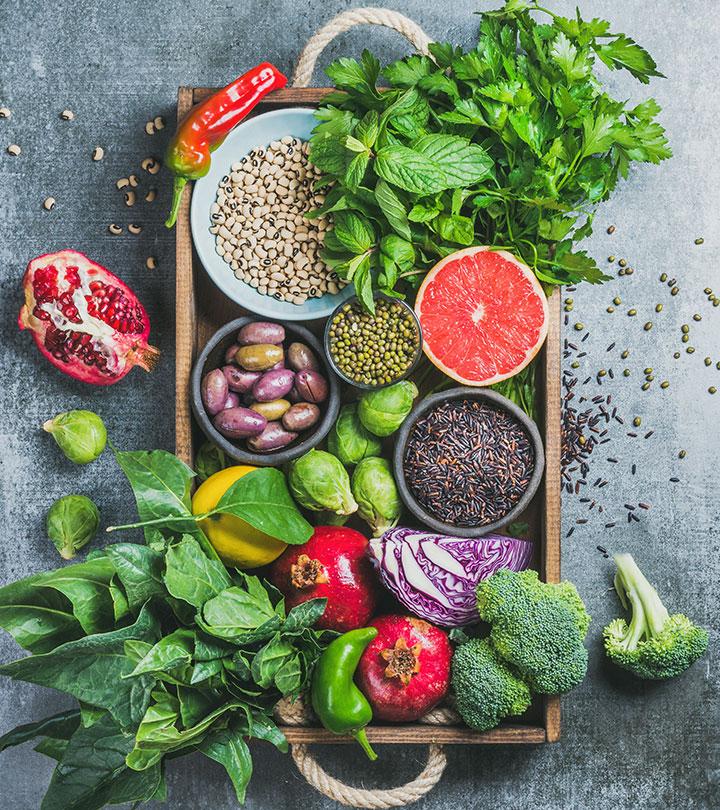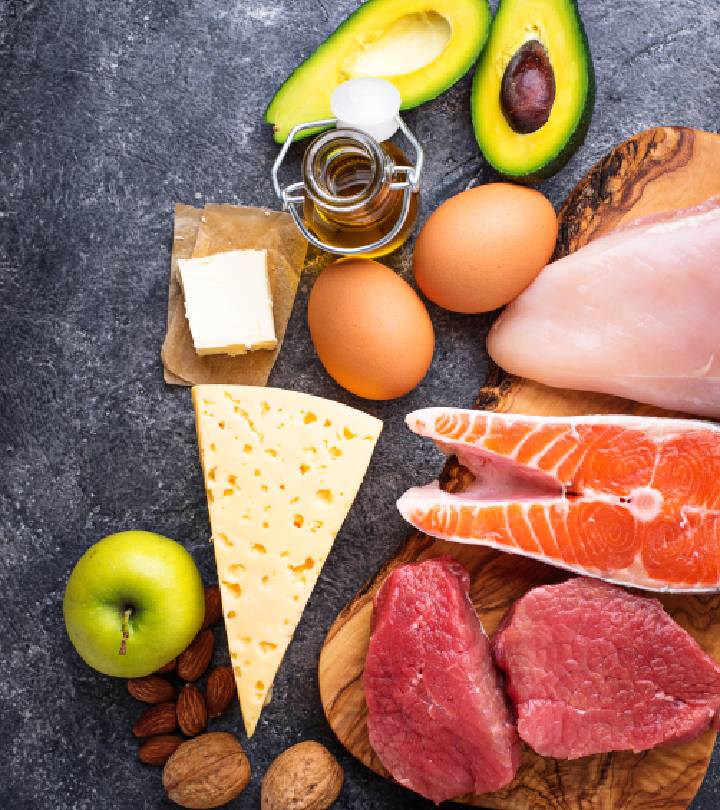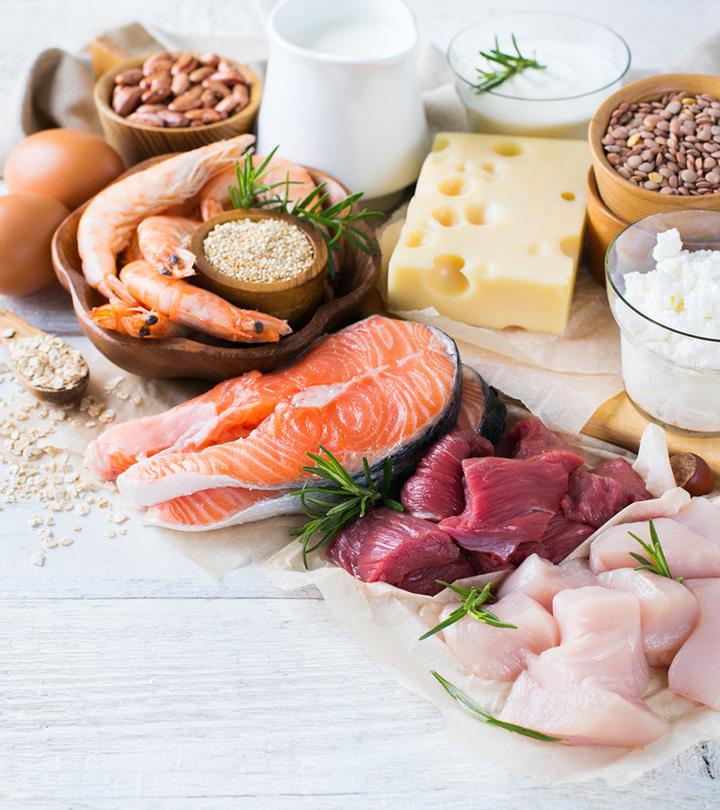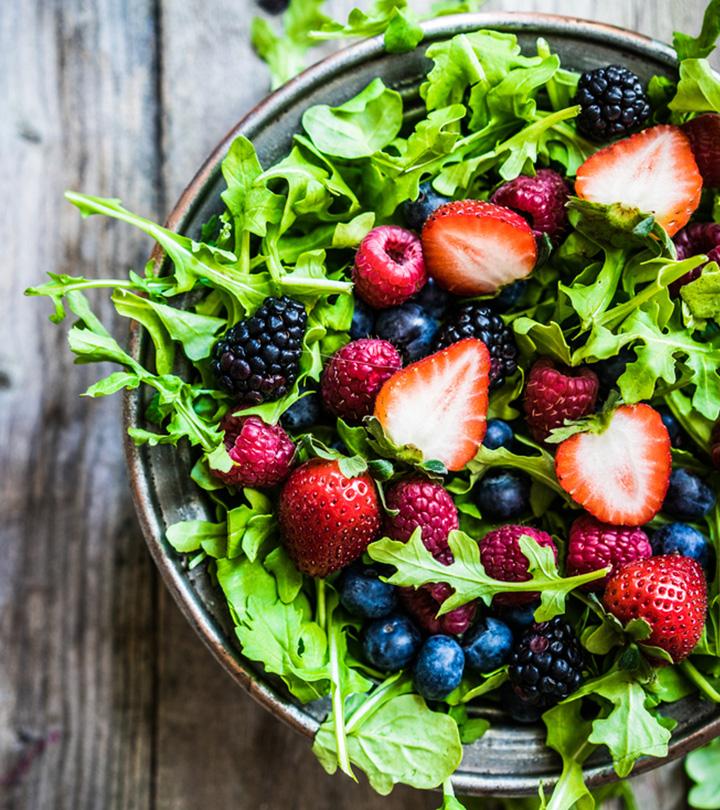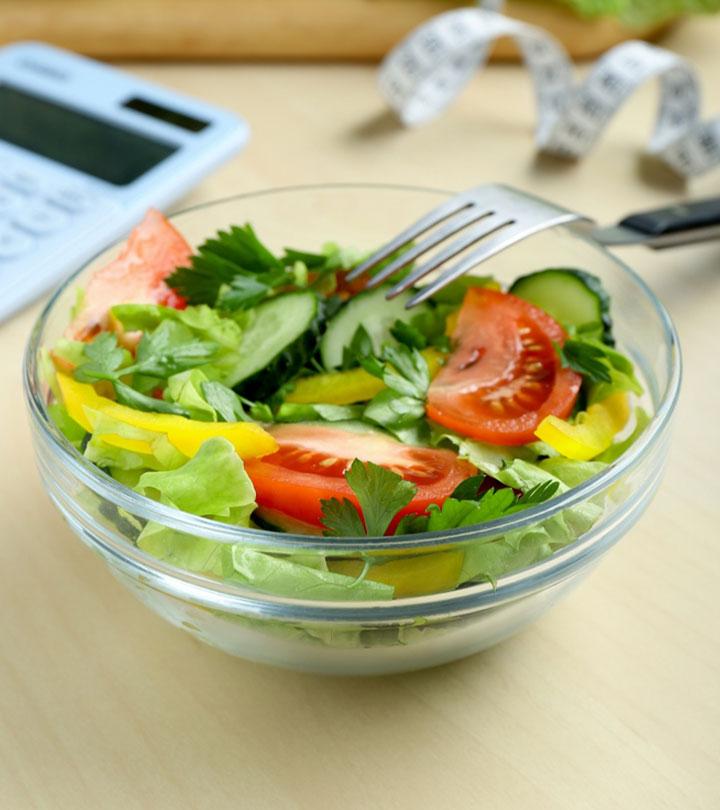How The Warrior Diet Plan Works – A Complete Guide To Lose Weight (Results, Meal Plan, And Benefits)
Be up in arms against excess body weight with this intermittent form of fasting.

Image: Shutterstock
The Warrior diet plan is a fast way to lose weight and become fit. If no other diet plan is working for you, you may give this diet plan a try.
Because the Warrior Diet is similar to intermittent fasting. It involves feasting during the night and fasting during the day. This helps keep your caloric intake in check and prevents excess fat accumulation.
Read on to know how the Warrior Diet plan works and everything else about it that you must know.
 At A Glance: The Warrior Diet
At A Glance: The Warrior Diet- Principle: Focuses on fasting for 20 hours with restrictive eating and overeating during the 4-hour window.
- Purpose: To improve optimal health and fitness level, help tone the body, and lose weight.
- Who It Is For: Individuals with obesity, high blood sugar, and blood pressure levels.
- Duration: Short-term
- Who Should Avoid: Children, pregnant and breastfeeding individuals, athletes, and individuals with eating disorders, thyroid conditions, hypertension, diabetes, kidney issues, and those who are underweight.
- Cons: May cause nutrient deficiencies, fatigue, depression, anger, insomnia, and hormonal imbalances
In This Article
What Is The Warrior Diet?
The Warrior Diet is a type of intermittent fasting created in 2001 by Ori Hofmekler, a renowned health and fitness writer.
This diet plan is based on the fact that in ancient times, warriors would exercise on an empty stomach. They would eat very less during the day and eat their kill at night. This eating and exercising routine kept the warriors toned and fit.
People who follow this diet fast for a 20-hour period and eat to the fullest in the 4-hour window.
You are allowed to eat anything (including unprocessed and sugary items) in the 4-hour window. There is no restriction on the food items. But in the 20 hours of fasting, you are encouraged to eat hard-boiled eggs, lots of fruits and vegetables, and small amounts of dairy products along with plenty of non-calorie fluids and water for hydration.
Another diet plan that the Warrior Diet is often compared to is OMAD. Learn about the differences between the two in the next section.
Warrior Diet Vs. OMAD
The Warrior Diet and OMAD (One Meal A Day) are both forms of intermittent fasting, but they differ in their approaches. The Warrior Diet usually involves fasting for 20 hours followed by a 4-hour eating window, usually in the evening. OMAD, on the other hand, involves a stricter regimen of fasting for 23 hours and consuming all daily calories in a single meal, often at the same time each day.
The choice between the two depends on personal preferences and lifestyle. Some individuals find the Warrior Diet’s shorter fasting window more manageable, as it allows small amounts of food during the day. OMAD can be more challenging due to the extended fasting period but offers the potential for more pronounced metabolic benefits and simplicity in meal planning.
Does The Warrior Diet Have Any Benefits?
The Warrior Diet is not backed by any scientific research, but intermittent fasting is.
Intermittent fasting is restricted to a 16:8 fasting window, and the Warrior Diet is restricted to a 20:4 feeding window.
Though it is implied that the benefits of intermittent fasting apply to the Warrior Diet as well, few people have argued against this as the feeding window of the latter is too short.
Scroll up to check out the benefits of following the Warrior Diet.
1. May Aid Weight Loss
A 20-hour fasting window is effective in aiding weight loss. A study conducted on healthy men and women found that eating one meal per day helps reduce body weight and fat mass compared to taking 3 meals per day (1).
Another study states that 25% energy-restricted intermittent fasting helps aids weight loss along with overall improvement in body composition (2).
Eating a balanced diet during the 4-hour feeding window is key in the Warrior Diet plan.
Austin Harty, a blogger, shared his experience of following the tried Warrior diet for two months in his blog. He said, “Over the two months I did see a reduction in my body fat percentage, although I do not know to what extent. The big thing for me was that I was still putting on muscle mass as I was losing body fat (i).
2. May Improve Heart Health
Studies have shown that intermittent fasting helps improve cardiovascular health over a period of time.
A study conducted on rodents showed that intermittent fasting without restricting calorie intake improves heart health (1).
Studies done on humans have revealed that intermittent fasting has the potential to lower blood pressure and cardiovascular risk factors (3).
3. May Improve Blood Sugar Control
Fasting is strongly related to blood sugar control and improved glucose tolerance.
A study published in the World Journal of Diabetes showed that short-term 18-20 hours intermittent fasting not only improves body composition but also controls fasting and post-meal glucose levels (4).
Another study revealed that therapeutic fasting improves HbA1C levels (glycosylated hemoglobini XGlucose (a type of sugar) molecules in the blood normally get stuck to hemoglobin molecules, making it glycosylated. ), which is one of the most important parameters to keep your blood sugar level under control (5).
Note: Always consult a doctor before doing any fasting. Prolonged fasting with diabetic medication may lead to hypoglycemiai XA condition in which the blood sugar level is lower than the standard range. Often caused by diabetes treatment and other conditions. (6).
4. May Improve Brain Health
According to scientific evidence, intermittent fasting improves cognitive function.
A study conducted on mice found that intermittent fasting can improve cognitive function and protect the brain from distress by controlling the inflammatory response pathwayi XCoordinated communication of immune cells and blood vessels through certain signals in response to infection or injury. (7).
Fasting also improves cognition (mental action or mental clarity), reduces brain damage, slows down age-related cognitive decline, and enhances recovery after stroke (8).
Austin Harty further added, “I also noticed that my focus improved throughout the day along with my energy levels as I became used to the diet.”
Now that you know all the potential health benefits of the Warrior Diet, let’s check out the guidelines to following it.
The Warrior Diet – Guidelines
1. Keep Yourself Hydrated
Drinking water is the most important thing in fasting. You can drink 9-10 glasses of water in the 20-hour window to maintain the hydration level in your body.
Make sure to drink filtered water. You can also fortify your water with nutrients by adding cucumber, mint, lemon, cinnamon, etc.
2. Eat Protein-Rich Foods
In the Warrior Diet, you are allowed to eat a substantial protein-rich dinner. This helps reduce carb intake and rebuild the worn-out muscles. You can also have protein powder with milk to give your body an extra dose of protein.
3. Eat One Main Meal
Unlike the conventional diet plans, the Warrior Diet requires dieters to eat one main meal, which is dinner. In this one-meal-diet-a-day, dieters are allowed to have low-calorie foods such as eggs, yogurt, legumes, veggies, and fruits for breakfast and lunch.
 Quick Tip
Quick Tip4. Learn To Control Hunger
We all know that eating every 3-4 hours will help in weight loss. But, the Warrior Diet does not advocate that. Like the warriors in the middle of a battle or hunt, you should train your brain to practice hunger suppression. When you do this for a few days, your body will eventually learn to stay away from food during the fasting phase.
5. Avoid Processed Foods
Any kind of processed food is not allowed when you are on the Warrior Diet. Processed foods contain higher amounts of sugar, salt, artificial flavors, colors, food preservatives, and taste enhancers that are very harmful to your health. You should buy natural products from a local grocery store. If you are eating out or ordering from a restaurant, avoid fried chicken, sausages, burgers, pizza, fries, and ketchup.
 Quick Tip
Quick Tip6. Exercise To Get Quick Results
Warriors spent a lot of time either fighting or hunting, which helped them expend a lot of energy. So, if you are on the Warrior Diet, you should exercise regularly to expend the energy and get back in shape. You can do a mix of cardio, strength training, weights, and yoga to keep the workout routine fun and engaging.
 Quick Tip
Quick TipSo, now that you have the guidelines, let’s take a look at the Warrior Diet Meal Plan.
How To Follow The Warrior Diet
The Warrior Diet Plan With Meal Timings
| MEALS | WHAT TO EAT |
|---|---|
| Early Morning (7:00- 7:45 a.m) | ● Warm water with 1 tablespoon honey and juice of ½ a lime |
| Breakfast (8:30 – 9:00 a.m) | Options: ● 1 boiled egg white OR ● 1 cup grapefruit juice with chia seeds OR ● 1 cup green tea |
| Lunch (12:30 – 1:00 p.m) | Options: ● Medium bowl of fruits OR ● 1 cup yogurt OR ● ½ cup raw vegetable salad (cucumber, Chinese cabbage, bell pepper) |
| Dinner (7:00 p.m) | Options ● Grilled chicken + mashed potato + Boiled Sauteed veggies + 1 small piece of dark chocolate + 1 cup warm milk with a pinch of turmeric OR ● 2 pita bread + kidney bean chili + grilled veggies + 1 small piece of dark chocolate + 1 cup buttermilk with roasted cumin powder OR ● Vegetable wheat pasta + 1 small portion of tiramisu + 1 cup warm milk with a pinch of turmeric OR ● Broccoli, carrot, and potato casserole + 2 tablespoons fruit custard |
Why This Works
You are technically allowed to eat three times a day in this diet plan.
- Starting your day with a glass of warm water, lime juice, and honey is a great way to flush the toxins out, improve bowel movement, and boost immunity. Studies have shown that lemon detox may help reduce body fat and improve insulin resistance (9).
- Breakfast will typically contain a good source of protein, healthy fat, and dietary fiber.
- Lunch should be a bare minimum, but nutritious. Fruits and veggies contain a good amount of vitamins, minerals, dietary fiber, and complex carbs. Yogurt is rich in good gut bacteria that aid digestion (10).
- For dinner, have a good portion of protein, complex carbs, and dessert to reward yourself and keep your taste buds alive.
Here is a food substitute list if you are allergic to any foods listed in the diet chart or are a picky eater.
The Warrior Diet – Food Substitutes
- Honey – ½ teaspoon Ceylon cinnamon powder
- Lime juice – Apple cider vinegar
- Egg – ¼th cup sprouts
- Almonds – Macadamia nuts
- Grapefruit juice – Garcinia cambogia powder
- Chia seeds – Flax seeds
- Green tea – Oolong tea
- Yogurt – Fruit or vegetable juice
- Cucumber – Carrot
- Chinese cabbage – Lettuce
- Bell pepper – Red cabbage or tomato
- Chicken – Salmon/tuna/tofu/mushroom
- Potato – Squash or sweet potato
- Dark chocolate – Medium piece of ripe mango
- Milk – Soy milk/almond milk
- Pita bread – Wheat flatbread
- Kidney bean – Garbanzo bean/peas
- Buttermilk – Grape and ginger juice
- Pasta – Brown rice
- Tiramisu – Brownie
- Broccoli – Cauliflower
- Carrot – Tomato
- Custard – 1 scoop vanilla ice cream
As mentioned before, apart from allowing yourself to take a long break between meals, you should also work out to actually make this diet work. So, here is a workout plan for you.
The Warrior Diet – Exercise Plan
Here, you will find a list of exercises that you can choose from. Make sure to warm up before starting and stretch when you finish exercising. You need to get at least 1 hour of exercise for 6 days a week. Start by getting 3 hours of exercise a week and gradually increase it to 6 hours. Do what you like the most as there are no hard and fast rules. If you like to play sports, go ahead with that. If not, opt for this routine:
- Neck tilt (right and left) – 1 set of 10 reps
- Neck rotations (clockwise and anticlockwise) – 1 set of 10 reps
- Shoulder rotations (clockwise and anticlockwise) – 1 set of 10 reps
- Arm rotations (clockwise and anticlockwise) – 1 set of 10 reps
- Wrist rotations (clockwise and anticlockwise) – 1 set of 10 reps
- Waist rotation (clockwise and anticlockwise) – 1 set of 10 reps
- Ankle rotation (clockwise and anticlockwise) – 1 set of 10 reps
- Standing side crunches (right and left) – 1 set of 10 reps
- Side lunges (right and left) – 1 set of 10 reps
- Bend over to touch your toes – 1 set of 10 reps
- Jumping jacks – 1 set of 10 reps
- Burpees – 2 sets of 10 reps
- Jumping squat – 1 set of 10 reps
- Forward lunges (with 1 kg weight) – 1 set of 10 reps
- Jumping forward lunges – 1 set of 10 reps
- Bicycle crunches – 2 sets of 10 reps
- Crunches – 2 sets of 10 reps
- Forward plank – 2 sets of a 20-second hold
- Side plank – 2 sets of a 20-second hold
- Scissor kicks – 2 sets of 10 reps
- Outward kicks – 2 sets of 10 reps
- Push-ups – 1 set of 10 reps
- Tricep dips – 2 sets of 5 reps
- Bicep curls (1 kg weight) – 2 sets of 5 reps
- Dance/swim/play a sport/bicycle/walk/run – 30-45 minutes
- Yoga/meditation – 30 – 45 minutes
- Stretch
Here is a list of foods to eat and avoid when following the Warrior Diet to get the best results.
What To Eat And What To Avoid
Dieters are allowed to eat anything organic, fresh, and seasonally grown. Processed and fried foods and sugary beverages are discouraged when you are on this diet.
Foods To Eat During The Fasting Window (In Small Proportions)
- Fruits And Vegetables: You are allowed to eat any fresh and seasonally-grown fruits and vegetables.
- Clear Broth: Chicken or beef
- Protein: Hard-boiled egg
- Dairy: Milk, yogurt, cottage cheese, etc.
- Beverages: Water, coffee, green tea, any fruit or vegetable juice (unstrained).
Foods To Eat During The Feeding Window (Without Restrictions)
- Grains: Whole grain bread, whole-wheat pasta, quinoa, brown rice, broken wheat, oats, barley.
- Vegetables: Any seasonal cooked vegetables.
- Protein: Chicken, seafood, beef, pork.
- Dairy: Milk, cheese, yogurt.
- Fats: Nuts and olive oil.
Foods To Avoid Completely
- Candies
- Cookies and cakes
- Chips
- Fried foods
- Processed meats (lunch meats, bacon)
- Refined carbohydrates
- Artificial sweeteners
- Sweetened drinks like fruit juice and soda
Now, the question is, how long should you follow this diet to get results? Here is your answer.
How Long Should You Follow The Warrior Diet?
You should follow the Warrior Diet for a month to get good results. By the time you complete a month on this diet, intermittent fasting will become a habit.
Now the main question is, what is the result of the Warrior Diet? Scroll further to know more.
Results Of The Warrior Diet
You feel light and energetic when you are on the Warrior Diet. You can also lose up to 10-15 pounds in a week. You can easily figure out whether your body is shrinking or there are body composition changes as you tend to lose a lot of water weight. You may also be able to fit into your old dresses. However, this is not a sustainable or healthy way to lose weight. You should only do it after prior consultation and under the supervision of a licensed medical practitioner.
How You Will Feel After Following The Warrior Diet?
Initially, it will be tough to control your hunger and stick to the diet plan. But, by the end of the third day, you will lose a lot of water weight, which will instantly make you look slimmer. You will feel less bloated and more active. Regular exercise will also help mobilize fat and build lean muscles and gain muscle mass instead of simple muscle gain.
Though the Warrior Diet is a good way to lose weight, it comes with its own set of cons. Check them out below.
Cons Of The Warrior Diet Plan
1. Difficult To Stick To A Specific Strict Diet Plan
One of the major downfalls of the Warrior Diet plan is that it requires you to stick to a specific time frame of fasting and feeding.
The 20-hour fasting window makes it a long-term fast, which is particularly difficult to follow when you have a busy schedule along with lifestyle management.
2. Not Suitable For Everyone
Any specific diet plan is not made for everyone. Since this diet involves a long fasting window, it is not suitable for:
- Children
- Pregnant and lactating women
- Athletes
- People with eating disorders
- People who are extremely underweight
- People with abnormal thyroid conditions
- People with hypertensioni XPersistently high blood pressure. Can eventually lead to illnesses like heart disease and stroke if left untreated.
- People with diabetes
- People with kidney issues or other serious health conditions
3. Nutrient Deficiencies
As this diet plan is restricted to a specific eating pattern, it may lead to certain nutrient deficiencies. Make sure to balance your eating window with nutrient-dense foods in the correct portions.
4. May Lead To Binge Eating
Fasting for a long period often causes people to crave lots of things when they break their fast. It is a kind of emotional eating to satisfy deprivation from food. People often end up binging on processed, fried foods in their 4-hour feeding period.
5. May Lead To Negative Side Effects
Following the Warrior Diet plan may lead to (11):
- Fatigue
- Feeling hungry all the time
- Fear of loss of control
- Depression
- Anger
- Lower energy levels
- Insomniai XThe condition characterized by difficulty falling asleep, staying asleep, or waking up too early and having trouble falling back asleep.
- Irritability
- Hormonal imbalance
If you are determined to follow the Warrior Diet Plan and shed some weight, seek advice from a nutritionist to plan your feeding and fasting windows in a balanced way.
Here are some additional precautions that you can take when following the Warrior Diet.
Precautions
- Drink enough water to stay hydrated.
- Eat nutritious foods in the feeding window.
- Break your fast with dry fruits to get instant energy.
- If you are feeling low on energy, do not exercise for long durations.
- Maintain a healthy lifestyle to manage your stress.
Infographic: Warrior Diet Plan: Benefits And Guidelines
The warrior diet plan is best for you if no other options are working for you as it focuses solely on meal-frequency. It requires you to fast for 20 hours and only consume one meal a day which incorporates all your necessary nutrients and minerals. To know more about the benefits and guidelines of this plan, check out the infographic below.
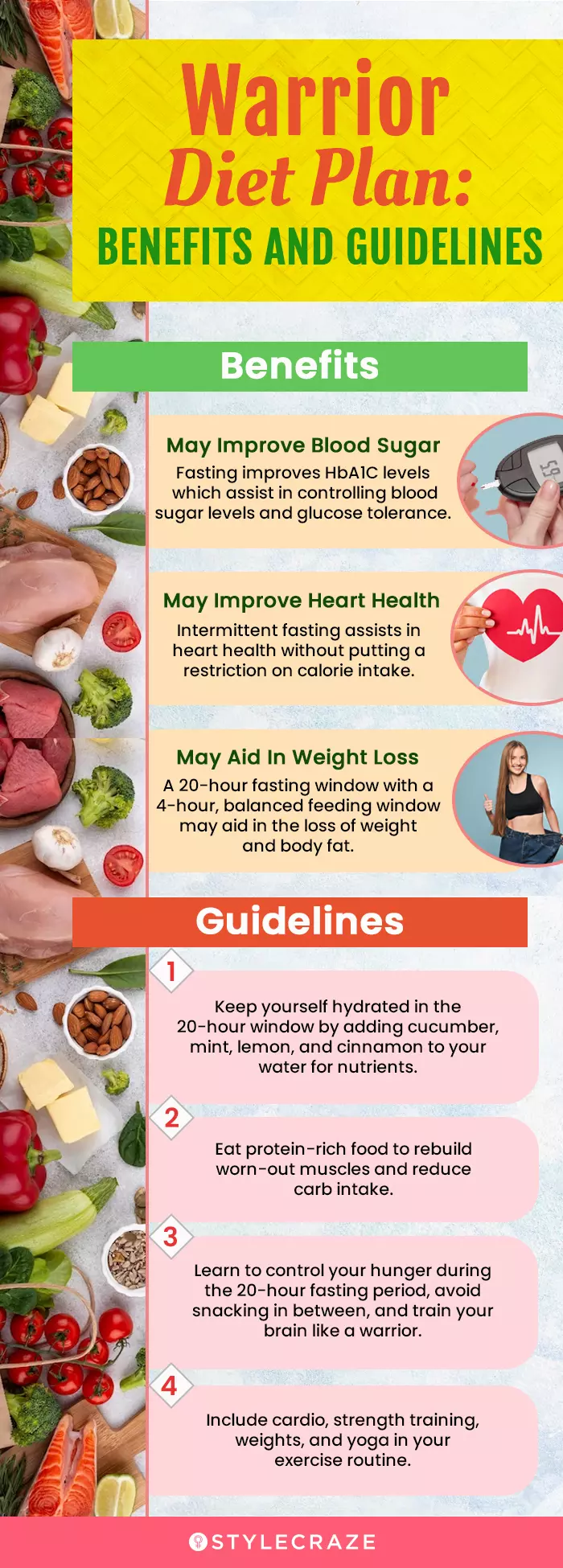
Illustration: StyleCraze Design Team
The warrior diet plan imposes minimum restrictions on the food intake during the four-hour window. Besides, you can also consume fruits, vegetables, water, and non-calorie fluids during the 20-hour fasting window, making it easier to follow. This diet aids in weight loss, fat loss, and regulating blood sugar levels, and helps improve cardiovascular and brain health. Along with the diet, exercising regularly and other lifestyle modification helps get faster results. However, this diet is not suitable for all individuals, especially children, pregnant and lactating women, athletes, etc. It may also lead to certain nutritional deficiencies. Therefore, consult a doctor before following this diet.
Frequently Asked Questions
How much weight can you lose on the Warrior Diet?
Weight loss varies based on body type. But, you can lose somewhere between 10-15 pounds in a week.
Is the warrior diet healthy?
As long as you follow a balanced approach when following the Warrior Diet, it can be healthy. But, do not under-eat in your feeding window as it may lead to nutrient deficiencies.
Does the Warrior Diet slow down your metabolism?
No type of intermittent fasting slows down metabolism. On the contrary, it helps revamp the metabolic system and clear off toxins to keep you healthy and active.
What is the warrior diet and how does it differ from traditional diets?
Inspired by ancient times, in the warrior diet, people fast for a 20-hour window and eat anything and everything in the 4-hour window just as the warriors do to keep their bodies toned and fit.
In a traditional diet, people eat in proper intervals, maintain a balance, and consume less fat and processed food.
Can the warrior diet be adapted to different lifestyles and dietary restrictions, such as veganism or gluten intolerance?
No, this diet is not suitable for different lifestyles and dietary restrictions, such as veganism or gluten intolerance.
How does the warrior diet differ compared to other popular diets, such as the paleo diet or ketogenic diet?
In the warrior diet, people fast for a 20-hour window and eat in a 4-hour window to keep the body toned and fit.
The paleo diet allows carbohydrate intake from whole foods such as fruits, vegetables, and unrefined sweeteners, while the keto diet restricts all food rich in carbohydrates, including starchy vegetables, most fruits, grains, sweeteners, and legumes.
Key Takeaways
- The Warrior Diet works on a 20:4 feeding ratio. During the 20 hours of fasting, we recommend having fruits, vegetables, and hard-boiled eggs.
- Warrior Diets like intermittent fasting may aid in reducing the risk of cardiovascular diseases.
- This is a high-protein diet plan, so it is essential to consume more protein and limit carbs.
- Regular exercising with a mix of strength training and cardio is crucial during the diet to support faster weight loss.

Image: Stable Diffusion/StyleCraze Design Team
Learn how to start 20:4 fasting with this beginner’s guide. Get tips on how to make the most of your Warrior Diet and start seeing results. Scroll down to watch the video.
Personal Experience: Source
StyleCraze's articles are interwoven with authentic personal narratives that provide depth and resonance to our content. Below are the sources of the personal accounts referenced in this article.
i. WHY I STARTED AND MY EXPERIENCE WITH THE WARRIOR DIEThttps://eatingthewarriorway.wordpress.com/2015/04/07/eating-the-evolutionary-way/
References
Articles on StyleCraze are backed by verified information from peer-reviewed and academic research papers, reputed organizations, research institutions, and medical associations to ensure accuracy and relevance. Read our editorial policy to learn more.
- A controlled trial of reduced meal frequency without caloric restriction in healthy, normal-weight, middle-aged adults, The American Journal of Clinical Nutrition, US National Library of Medicine, National Institutes of Health.
https://www.ncbi.nlm.nih.gov/pmc/articles/PMC2645638/ - The effects of intermittent or continuous energy restriction on weight loss and metabolic disease risk markers: A randomized trial in young overweight women, Randomized Controlled Trial, US National Library of Medicine, National Center for Biotechnology Information, National Institutes of Health.
https://pubmed.ncbi.nlm.nih.gov/20921964-the-effects-of-intermittent-or-continuous-energy-restriction-on-weight-loss-and-metabolic-disease-risk-markers-a-randomized-trial-in-young-overweight-women/ - Intermittent fasting in cardiovascular disorders- An overview, Nutrients, US National Library of Medicine, National Institutes of Health.
https://www.ncbi.nlm.nih.gov/pmc/articles/PMC6471315/ - Effects of intermittent fasting on health markers in those with type 2 diabetes: A pilot study, World Journal of Diabetes, US National Library of Medicine, National Institutes of Health.
https://www.ncbi.nlm.nih.gov/pmc/articles/PMC5394735/ - Therapeutic use of intermittent fasting for people with Type 2 diabetes as an alternative to insulin, Case Reports, US National Library of Medicine, National Center for Biotechnology Information, National Institutes of Health.
https://pubmed.ncbi.nlm.nih.gov/30301822-therapeutic-use-of-intermittent-fasting-for-people-with-type-2-diabetes-as-an-alternative-to-insulin/ - Intermittent fasting in type 2 diabetes mellitus and the risk of hypoglycaemia: A randomized controlled trial, Randomized Controlled Trial, US National Library of Medicine, National Center for Biotechnology Information, National Institutes of Health.
https://pubmed.ncbi.nlm.nih.gov/29405359-intermittent-fasting-in-type-2-diabetes-mellitus-and-the-risk-of-hypoglycaemia-a-randomized-controlled-trial/ - Intermittent fasting could ameliorate cognitive function against distress by regulation of inflammatory response pathway, Journal of Advanced Research, US National Library of Medicine, National Institutes of Health.
https://www.ncbi.nlm.nih.gov/pmc/articles/PMC5608558/ - Fasting as a therapy in neurological disease, Nutrients, US National Library of Medicine, National Institutes of Health.
https://www.ncbi.nlm.nih.gov/pmc/articles/PMC6836141/ - Lemon detox diet reduced body fat, insulin resistance, and serum hs- CRP level without haematological changes in overweight Korean women, Randomized Controlled Trial, US National Library of Medicine, National Center for Biotechnology Information, National Institutes of Health.
https://pubmed.ncbi.nlm.nih.gov/25912765-lemon-detox-diet-reduced-body-fat-insulin-resistance-and-serum-hs-crp-level-without-hematological-changes-in-overweight-korean-women/ - Elli, Marina, et al. “Survival of yogurt bacteria in the human gut.” Appl. Environ. Microbiol. 72.7 (2006): 5113-5117.
https://www.ncbi.nlm.nih.gov/pmc/articles/PMC1489325/ - Potential benefits and harms of intermittent energy restriction and intermittent fasting amongst obese, overweight and normal weight subjects_ A narrative review of human and animal evidence, Behavioral Sciences, US National Library of Medicine, National Institutes of Health.
https://www.ncbi.nlm.nih.gov/pmc/articles/PMC5371748/






